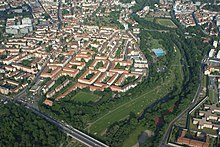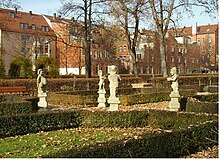St. Johannis (Nuremberg)
|
St. Johannis
Statistical District 07 City of Nuremberg
Coordinates: 49 ° 27 '32 " N , 11 ° 3' 47" E
|
|
|---|---|
| Area : | 59.4 ha |
| Residents : | 8078 (December 31, 2015) |
| Population density : | 13,599 inhabitants / km² |
| Incorporation : | October 1, 1825 |
| Incorporated into: | Nuremberg |
| Postal code : | 90419 |
| Area code : | 0911 |
|
Location of the statistical district 07 St. Johannis (Nuremberg) in Nuremberg
|
|
St. Johannis is a district and the name of the district 3434 of Nuremberg .
geography
It is located west of the old town north of the Pegnitz and consists of the statistical district 07 (St. Johannis) and the districts 23 ( Sandberg ) and 24 (Bielingplatz).
| Neighboring statistical districts | |||||||||
|---|---|---|---|---|---|---|---|---|---|
|
history
In 1234 the Siechkobel St. Johannis was first mentioned as a leprosy station . In 1307, Queen Elisabeth , wife of Albrecht I of Habsburg (1298–1308), gave the "Johannisfelder" to the Siechkobel. In 1354 Berthold Haller founded the pilgrims' hostel "Heilig-Kreuz-Spital", in whose nursing home the Haller family had the right to live from 1354 until it was destroyed in 1945.
In 1427 the castle was sold to the city of Nuremberg by the Hohenzollern family , but Johannis remained a fiefdom of the princes as a land area . The painter and art theorist Albrecht Dürer died in 1528 and was buried in the Johannisfriedhof . After the Prussians occupied the land areas of Nuremberg, St. Johannis became an independent rural parish. In 1806 the old Siechkobel was closed and rebuilt into the inn " Zum golden Adler" .
At the end of the 18th century there were 15 properties in St. Johannis. The high court exercised the imperial city of Nuremberg , but this was disputed by the Brandenburg-Bayreuth Oberamt Baiersdorf . The landlords were the "Siechkobel St. Johannis" (Siechkobel with public bar, rectory, schoolhouse, stone clerk's house, church, wooden shoe chapel, 2 half courtyards), the war office (barracks with 7 buildings), civil rifle society (shooting house).
In 1806 St. Johannis came to Bavaria . As part of the municipal edict, the St. Johannis tax district was formed in 1808 , to which Großweidenmühle and St. Sebastian belonged. In 1810 the municipal community of St. Johannis was formed, which was congruent with the tax district. In administration and jurisdiction it was subordinate to the Regional Court of Nuremberg and in financial administration to the Fürth Rent Office . In voluntary jurisdiction, 1 property was subject to the Patrimonial Court (PG) Groß- und Kleingeschaidt from 1821 to 1835 , 3 properties until 1812 and from 1823 to 1835 to the PG Lohe and 2 properties from 1824 to 1848 to the PG Ziegelstein . On October 1, 1825, St. Johannis was incorporated into Nuremberg .
In 1862 William Wilson , the engine driver for the Adler on the first German railway line between Nuremberg and Fürth, was buried in the Johannisfriedhof.
The school building was erected in Adam-Kraft-Strasse in 1882, and another followed in 1913/1914 on Bielingplatz (today's Peter Vischer School ). The Friedenskirche on Palmplatz was built between 1925 and 1928 according to plans by German Bestelmeyer and destroyed in a bomb attack in 1944 during World War II. In 1950, the two-year reconstruction followed.
After the opening of the Westfriedhof in 1880, residential and commercial development began on Sandberg, the area between Johannis- and Westfriedhof. At that time it still belonged to the neighboring community of Wetzendorf , which was not incorporated into Nuremberg until 1898 . The development of Sandberg continued in the years up to the First World War and was essentially completed with the wbg settlement from 1927 to 1932. For the history of Sandberg see also: Sandberg (Nuremberg) #History .
Population development
| year | 1818 | 1824 | 1840 | 1871 | 1885 |
|---|---|---|---|---|---|
| Residents | 997 | 901 | 1046 | 2247 | 3864 |
| Houses | 145 | 111 | 156 | 304 | |
| source |
religion
The place has been predominantly Protestant since the Reformation. The residents of the Evangelical Lutheran denomination are parish to St. Johannis or the Friedenskirche , the residents of the Roman Catholic denomination are parish to St. Michael .
Attractions
In District 07 St. Johannis
- Baroque garden
- The Hesperides Gardens, gardens laid out by rich Nuremberg patricians in the baroque period. These were restored between 1980 and 1982.
- The medieval Johanniskirche with the Johannisfriedhof . In the cemetery there are numerous tombs with artistic epitaphs that are well worth seeing , showing inscriptions, coats of arms and figurative or ornamental representations.
- Pegnitzgrund
- The Evangelical Lutheran Church of Peace: There is the altar by an unknown master , which was originally made for the Augustinian monastery in Nuremberg, which no longer exists.
- Kärwa , which takes place every year in June
- Way of the Cross of Jesus with reliefs by the sculptor Adam Kraft , created between 1505 and 1508
- The Orpheum , a cinema building erected in 1949
In District 23 Sandberg
In District 24 Bielingplatz
sports clubs
- SV St. Johannis 07 e. V. Nuremberg
- TSV Johannis 1883 Nuremberg e. V.
- Turnerbund St. Johannis 1888 e. V. Nuremberg
- DJK Bayern Nürnberg e. V. 1923
- PVSbaskets
education
- Peter Vischer School , Gymnasium and Realschule
- Dr. Theo Schöller School , Schnieglinger Strasse
- Primary school St. Johannis
literature
- Johann Kaspar Bundschuh : St. Johannes . In: Geographical Statistical-Topographical Lexicon of Franconia . tape 5 : S-U . Verlag der Stettinische Buchhandlung, Ulm 1802, DNB 790364328 , OCLC 833753112 , Sp. 59 ( digitized version ).
- Günther P. Fehring , Anton Ress , Wilhelm Schwemmer: The city of Nuremberg (= Bavarian art monuments . Volume 10 ). 2nd Edition. Deutscher Kunstverlag, Munich 1977, ISBN 3-422-00550-1 , p. 409-475 .
- Wiltrud Fischer-Pache: Johannis (district) . In: Michael Diefenbacher , Rudolf Endres (Hrsg.): Stadtlexikon Nürnberg . 2nd, improved edition. W. Tümmels Verlag, Nuremberg 2000, ISBN 3-921590-69-8 , p. 498 ( online ).
- Hanns Hubert Hofmann : Nuremberg-Fürth (= Historical Atlas of Bavaria, part Franconia I, 4). Commission for Bavarian State History, Munich 1954, DNB 452071224 , p. 150 ( digitized version ). Ibid. S. 240-241 ( digitized version ).
- Erich Mulzer : Freye Franconia are celebrating in a free city. A garden festival in St. Johannis 1754. In: Nürnberger Altstadtberichte, Ed .: Altstadtfreunde Nürnberg e. V. , issue 18 (1993)
- History for everyone e. V. (Ed.): St. Johannis. History of a district, Nuremberg 2000, ISBN 3-930699-21-4 .
Web links
- District data sheet Nuremberg - Statistical District 07 St. Johannis , as of 2015 (PDF; 117 kB)
- St. Johannis in the historical directory of the association for computer genealogy
- Image film by the WBG Nürnberg Group about the Sankt Johannis district
Individual evidence
- ^ City of Nuremberg, Office for Urban Research and Statistics for Nuremberg and Fürth (ed.): Statistical Yearbook of the City of Nuremberg 2016 . December 2015, ISSN 0944-1514 , 18 Statistical City Districts and Districts, p. 244–245 , p. 244 ( nuernberg.de [PDF; 6.3 MB ; accessed on November 1, 2017]).
- ↑ a b City of Nuremberg, Office for Urban Research and Statistics for Nuremberg and Fürth (ed.): Statistical Yearbook of the City of Nuremberg 2016 . December 2015, ISSN 0944-1514 , 18 Statistical City Districts and Districts, p. 19-20 , p. 19 ( nuernberg.de [PDF; 6.3 MB ; accessed on November 1, 2017]).
- ↑ St. Johannis in the Bavaria Atlas
- ↑ HH Hofmann, p. 150.
- ^ W. Fischer-Pache, p. 498.
- ↑ HH Hofmann, p. 240; Address and statistical handbook for the Rezatkreis in the Kingdom of Baiern . Buchdruckerei Chancellery, Ansbach 1820, p. 62 ( digitized version ).
- ^ Wilhelm Volkert (ed.): Handbook of Bavarian offices, communities and courts 1799–1980 . CH Beck, Munich 1983, ISBN 3-406-09669-7 , p. 602 .
- ↑ Only inhabited houses are given. In 1818 these are known as fireplaces , in 1840 as houses , and from 1871 to 1885 as residential buildings.
- ↑ Alphabetical index of all the localities contained in the Rezatkkreis according to its constitution by the newest organization: with indication of a. the tax districts, b. Judicial Districts, c. Rent offices in which they are located, then several other statistical notes . Ansbach 1818, p. 79 ( digitized version ). St. Johannis: 989 inhabitants, 146 fireplaces; Großweidenmühle (p. 33): 8 E., 1 F.
- ↑ HH Hofmann, p. 240.
- ↑ Eduard Vetter (Ed.): Statistical handbook and address book of Middle Franconia in the Kingdom of Bavaria . Self-published, Ansbach 1846, p. 16 ( digitized version ). St. Johannis: 851 inhabitants, 135 houses; Großweidenmühle: 118 E., 15 H .; St. Sebastian: 77 E., 6 H.
- ↑ Kgl. Statistical Bureau (ed.): Complete list of localities of the Kingdom of Bavaria. According to districts, administrative districts, court districts and municipalities, including parish, school and post office affiliation ... with an alphabetical general register containing the population according to the results of the census of December 1, 1875 . Adolf Ackermann, Munich 1877, 2nd section (population figures from 1871, cattle figures from 1873), Sp. 1143 , urn : nbn: de: bvb: 12-bsb00052489-4 ( digital copy ).
- ↑ K. Bayer. Statistical Bureau (Ed.): Localities directory of the Kingdom of Bavaria. According to government districts, administrative districts, ... then with an alphabetical register of locations, including the property and the responsible administrative district for each location. LIV. Issue of the contributions to the statistics of the Kingdom of Bavaria. Munich 1888, Section III, Sp. 1082 ( digitized version ).







